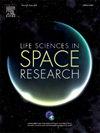具有杀菌活性的固体火箭发动机绝缘胶粘剂促进了深空任务的行星保护
IF 2.8
3区 生物学
Q2 ASTRONOMY & ASTROPHYSICS
引用次数: 0
摘要
为了防止外星生物圈受到微生物污染,NASA制定了减少航天器生物负荷的行星保护要求。对于在冰冷的外行星卫星上着陆的任务,通常用作离轨和制动阶段的固体火箭发动机(SRM)对行星保护特别重要,因为在航天器制造和组装期间可能发生微生物污染,SRM的碎片在撞击后可能散布在行星表面的大部分地区。在用于深空任务的概念航天器设计中,某些SRM区域预计在降落在木卫二冰冷且可能可行的表面之前无法达到足够的灭菌温度。本研究评估了SRM设计中常用的候选引物、粘合剂和绝缘体的抗菌性能。我们观察到,当将Chemlok®205 + 6450粘合剂涂在聚苯并咪唑(PBI)绝缘基质上时,与无粘合剂对照相比,使用Chemlok®205 + 6450粘合剂可显著减少萎缩芽孢杆菌(75.0%)、短小芽孢杆菌(88.9%)或枯草芽孢杆菌(87.6%)的活孢子数量。与测试的其他绝缘类型相比,将粘合剂应用于PBI绝缘后,观察到活孢子的减少更加一致。Chemlok®205引物的水提取物被观察到具有杀孢活性,LC-MS分析表明存在多种预计具有抗菌活性的水溶性化合物。本研究中观察到的活孢子回收率的降低是由于粘合剂中存在的杀孢化合物,绝缘类型的孢子结合能力以及由于冷冻磨削对孢子的物理损伤。火箭发动机底漆、粘合剂和绝缘材料中的化合物可以为行星保护做出贡献,特别是在登陆外行星冰冷卫星的任务中。可以优化绝缘材料和粘合剂的组合,以减少生物负担,并最终减轻行星保护风险。本文章由计算机程序翻译,如有差异,请以英文原文为准。
Solid rocket motor insulation adhesives with sporicidal activity promote planetary protection for deep space missions
To prevent microbial contamination of extraterrestrial biospheres, NASA has established planetary protection requirements for spacecraft bioburden reduction. For missions to land on the icy moons of the outer planets, solid rocket motors (SRM) commonly used as de-orbit and braking stages are of particular concern for planetary protection since microbial contamination may occur during spacecraft manufacturing and assembly and debris from the SRM can spread over large portions of the planetary surface after impact. In concept spacecraft designs for deep space missions, certain SRM regions are not expected to reach temperatures sufficient for sterilization prior to landing on Europa's icy and potentially viable surface. This study evaluated the antimicrobial properties of candidate primers, adhesives, and insulations commonly used in SRM designs. We observed significant reductions in the number of viable spores of Bacillus atrophaeus (75.0%), Bacillus pumilus (88.9%) or Bacillus subtilis (87.6%) by application of the Chemlok® 205 + 6450 adhesive, compared to no-adhesive controls, when applied onto a polybenzimidazole (PBI) insulation substrate. More consistent reductions in viable spores were observed after adhesives were applied to PBI insulation compared to other insulation types tested. An aqueous extract of Chemlok® 205 primer was observed to have sporicidal activity, and LC-MS analysis indicated the presence of multiple water-soluble compounds predicted to have antibacterial activity. The reduction in recovery of viable spores observed in this study was due to sporicidal compounds present in adhesives, the spore-binding capacity of insulation types, and physical damage to spores due to cryogrinding. Compounds within rocket motor primers, adhesives, and insulations can contribute to planetary protection efforts, particularly in missions to land on the icy moons of the outer planets. The combination of insulation and adhesive may be optimized for the purpose of bioburden reduction, and ultimately planetary protection risk mitigation.
求助全文
通过发布文献求助,成功后即可免费获取论文全文。
去求助
来源期刊

Life Sciences in Space Research
Agricultural and Biological Sciences-Agricultural and Biological Sciences (miscellaneous)
CiteScore
5.30
自引率
8.00%
发文量
69
期刊介绍:
Life Sciences in Space Research publishes high quality original research and review articles in areas previously covered by the Life Sciences section of COSPAR''s other society journal Advances in Space Research.
Life Sciences in Space Research features an editorial team of top scientists in the space radiation field and guarantees a fast turnaround time from submission to editorial decision.
 求助内容:
求助内容: 应助结果提醒方式:
应助结果提醒方式:


